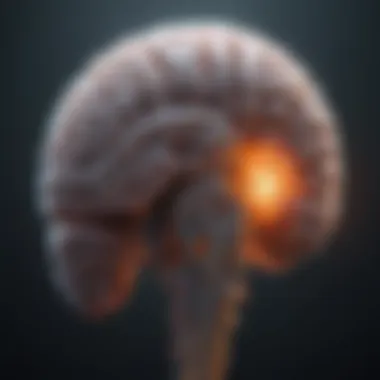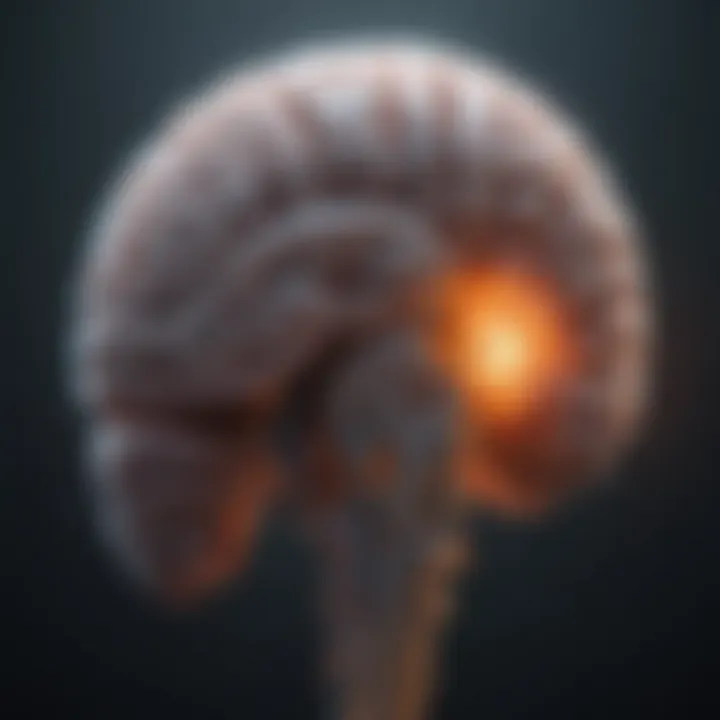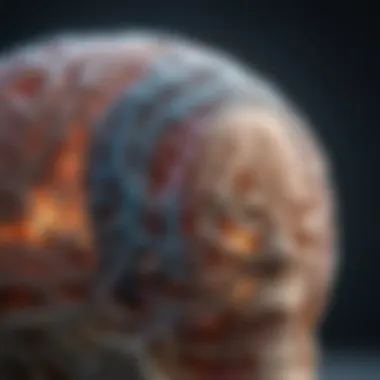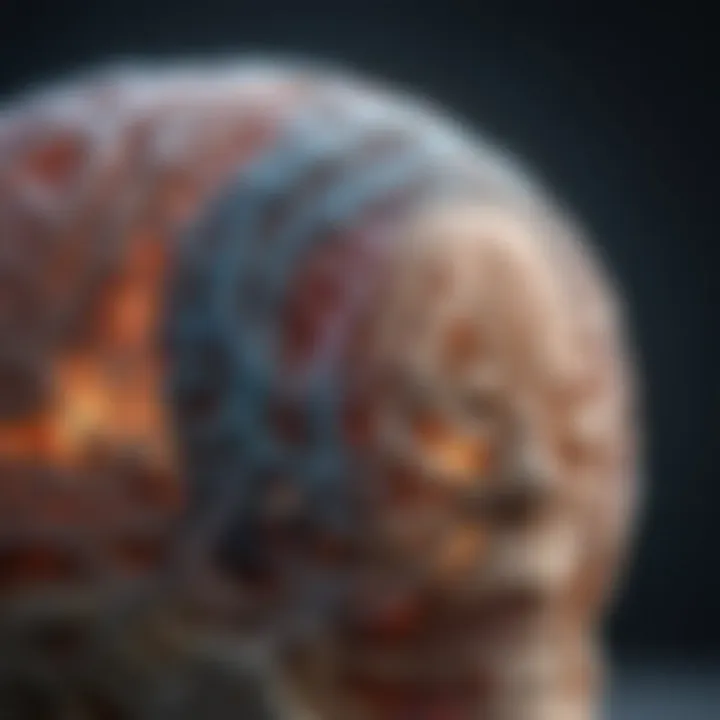Understanding Tumors in Brain MRI: An In-Depth Exploration


Intro
This article explores the complex interactions between MRI technology and brain tumor detection. As brain tumors pose significant challenges in terms of diagnosis and treatment, understanding the nuances of MRI plays a crucial role in clinical practice. An MRI, or magnetic resonance imaging, utilizes powerful magnets and radio waves to create detailed images of the brain. These images can reveal various types of tumors, playing a fundamental role in both diagnosis and ongoing management of patients.
MRI technology has evolved over several decades, leading to improvements in the precision and accuracy of tumor detection. This article aims to illuminate the multifaceted relationship between MRI scans and brain tumors, detailing the technical aspects of MRI, the types of tumors identifiable through this method, and how these images are interpreted by medical professionals. Furthermore, it discusses current advancements in MRI techniques, any challenges faced in accurate diagnosis, and the future landscape of neuroimaging research.
By navigating these topics, we hope to provide a well-rounded perspective that is valuable to students, researchers, educators, and professionals engaged in relevant fields. The depth of analysis here is intended to support a scientifically literate audience seeking to deepen their understanding of the role MRI plays in the identification and management of brain tumors.
Article Overview
Purpose of the Article
The primary aim of this article is to dissect the various functionalities and implications of MRI scans in the context of brain tumors. A deeper comprehension of how MRI operates can illuminate its crucial role in identifying and managing brain-related pathologies. With the rise of new imaging techniques and protocols, there is a pressing need to review these advancements alongside their practical applications in clinical settings.
Relevance to Multiple Disciplines
The discussion surrounding MRI and brain tumors intersects with numerous disciplines beyond radiology. Fields such as neurology, oncology, and biomedical engineering are directly impacted by advances in neuroimaging. Enhanced MRI techniques can significantly influence treatment plans and outcomes, fostering interdisciplinary collaboration.
Research Background
Historical Context
Magnetic resonance imaging emerged in the late 1970s, revolutionizing medical diagnostics. Initially, its application was mostly limited to soft tissues. However, as technology evolved, its integration into brain imaging saw considerable advancements, particularly in tumor detection. Understanding the historical developments informs current practices and highlights ongoing innovations in MRI.
Key Concepts and Definitions
To fully grasp the scope of the article, it is vital to familiarize oneself with some key concepts:
- Magnetic Resonance Imaging (MRI): A non-invasive imaging technique that uses strong magnetic fields and radio waves to produce detailed images of organs and tissues.
- Brain Tumors: Abnormal growths of tissue in the brain. They can be benign or malignant, affecting normal brain function.
- Diffusion Weighted Imaging (DWI): An advanced MRI technique that helps in the detection of cellular density changes, often associated with tumors.
Understanding these terminologies sets a solid foundation for exploring more intricate discussions regarding tumor identification and the implications of MRI findings.
Intro to Brain MRI
Understanding Brain Magnetic Resonance Imaging (MRI) is fundamental to modern neuroimaging practices. MRI has revolutionized how medical professionals detect and analyze brain tumors. Its non-invasive nature, combined with high-resolution imaging, allows for detailed visualization of brain structures. This technology not only enhances diagnostic accuracy but also plays a critical role in treatment planning and monitoring the progression of various tumor types.
MRI is particularly important because it offers a range of benefits. Firstly, it does not use ionizing radiation, making it safer for patients compared to other imaging techniques such as CT scans. The contrast achieved through MRI is superior, providing clearer distinctions between different types of tissues. This clarity aids in identifying the presence of tumors, their sizes, and their exact locations.
Moreover, the ability to produce images in multiple planes—sagittal, coronal, and axial—further increases the potential for precise diagnosis. This aspect is crucial for neurosurgeons and oncologists who must make informed decisions based on accurate readings of MRI scans.
It is also vital to consider how patient preparation and approach to imaging can affect outcomes. Factors such as the presence of implants, claustrophobia, or movement can influence the quality of the MRI scan. Understanding these considerations is essential in a clinical setting.
In summary, this section illuminates the significance of Brain MRI in diagnostic imaging, highlighting its advantages and the necessary considerations for effective use.
Fundamentals of Magnetic Resonance Imaging
Magnetic Resonance Imaging employs the principles of nuclear magnetic resonance to generate images of the organs and tissues within the body. The process begins when a patient is placed inside a powerful magnetic field. This field aligns the hydrogen atoms in the body, which are abundant in water and fat.
Once aligned, radiofrequency pulses are sent to the area of interest, causing the atoms to emit signals as they return to their normal state. These signals are then captured by the MRI machine and processed to create images. The resulting images offer insights into both the anatomy and pathology of the brain.
MRI can differentiate between various types of tissues. Tumors, for instance, can display distinct characteristics on MRI scans. They may appear brighter or darker compared to normal brain tissue. This difference assists radiologists in identifying abnormalities that may indicate tumor presence.
Furthermore, employing various MRI techniques such as T1-weighted, T2-weighted, and fluid-attenuated inversion recovery (FLAIR) sequences can enhance tumor detection. Each technique provides unique information based on the properties of the tissue being imaged.
Historical Development of MRI Technology
The journey of MRI technology began in the 1970s. The invention of the first MRI scanner can be attributed to Dr. Raymond Damadian, who recognized that cancerous tissue could be distinguished from normal tissue using nuclear magnetic resonance techniques.


In the subsequent years, technological advancements led to the development of better imaging techniques and higher magnetic field strengths, increasing the resolution and clarity of the images produced. Researchers and engineers made significant strides throughout the 1980s and 1990s, culminating in the development of functional MRI (fMRI), which reveals brain activity by detecting changes in blood flow.
Today’s MRI machines are more sophisticated, incorporating advanced software and powerful magnets. Continuous research in this field aims to improve imaging quality and reduce scan times, further enhancing the utility of MRI in clinical practices. As a result, MRI has become a standard tool in neurology and oncology, critical for diagnosing brain tumors and planning appropriate treatment strategies.
MRI technology has transformed how we visualize and understand the complexities of the human brain, particularly in the realm of tumor detection.
MRI technology has transformed how we visualize and understand the complexities of the human brain, particularly in the realm of tumor detection.
Mechanisms of MRI in Tumor Detection
Understanding the mechanisms of MRI in tumor detection is crucial for medical professionals and researchers. MRI technology harnesses the principles of magnetic fields and radio waves to visualize internal structures. This mechanism is especially important in detecting brain tumors precisely, enabling better diagnosis and treatment planning.
How MRI Captures Brain Image
MRI captures images of the brain by generating a strong magnetic field around the patient. Protons in the body, particularly those in water molecules, align themselves with the magnetic field. When a radio frequency pulse is applied, these protons are knocked out of alignment. Once the pulse is turned off, the protons return to their original alignment, releasing energy in the process. This released energy is detected and processed to create detailed images of the brain.
The resulting images offer high contrast between different tissues. Tumors often have distinct properties compared to normal brain tissue, which aids in their identification. The resolution of MRI can effectively reveal the tumor's size, location, and relationship to surrounding structures, which is vital for accurate diagnosis.
Contrast Agents and Their Role
Contrast agents, or contrast media, play a significant role in enhancing MRI images. These substances are administered intravenously before the scan begins. The agents often contain gadolinium, a metal that alters the magnetic properties of nearby water molecules. This alteration creates contrast between the tumor and normal tissue, making tumors more visible in the MRI images.
"The use of contrast agents can significantly improve the detection rate of brain tumors, especially in complex cases where differentiation from normal tissue is challenging."
"The use of contrast agents can significantly improve the detection rate of brain tumors, especially in complex cases where differentiation from normal tissue is challenging."
It is essential to consider the risks associated with contrast agents, though they are generally safe. Patients with kidney issues may face adverse reactions, and appropriate screening is necessary before administration. Understanding these aspects of contrast agents is vital for healthcare providers to enhance the efficacy of MRI in tumor detection.
Types of Brain Tumors Visible on MRI
Understanding the types of brain tumors visible on MRI is essential for several reasons. There is a significant variety of brain tumors, and recognizing them aids in diagnosis and treatment. Different tumors have distinct biological behaviors, which impact how they should be treated. Moreover, MRI technology plays a crucial role in visualizing these tumors, helping healthcare professionals to assess their size, location, and possible involvement of surrounding brain structures. Hence, the comprehension of tumor types is a foundational aspect of neuroimaging practice.
Primary Brain Tumors
Primary brain tumors originate in the brain or its nearby structures. They can vary widely in type and aggressiveness. Common examples include gliomas, meningiomas, and pituitary adenomas. MRI is particularly effective at identifying these tumors due to their unique characteristics. For example, gliomas often appear as areas of increased signal on T2-weighted MRI scans, while meningiomas typically present as dural-based lesions that may displace adjacent brain tissue.
The importance of identifying primary tumors lies in the treatment strategy. Surgical removal, radiotherapy, and chemotherapy may all be viable options. Understanding the type of tumor allows clinicians to tailor their approach based on tumor grade and histological type. Moreover, MRI enables continuous monitoring to detect any recurrence after treatment.
Secondary (Metastatic) Brain Tumors
Secondary brain tumors, or metastatic tumors, arise when cancer from another part of the body spreads to the brain. This is a common occurrence as many types of cancer can metastasize, including lung, breast, and melanoma. MRI is proficient in detecting these metastatic lesions, often appearing as larger lesions compared to primary tumors. They typically present as ring-enhancing lesions following the administration of contrast agents during MRI scans.
The identification of metastatic tumors is critical because they often indicate systemic disease. As such, managing the primary cancer may require a different strategy than one employed for primary brain tumors. Treatment could involve whole-brain radiotherapy or targeted therapies specific to the primary cancer type.
Benign vs Malignant Tumors
The distinction between benign and malignant tumors is fundamental in neuro-oncology. Benign tumors generally grow slowly and have less aggressive behavior, while malignant tumors can invade surrounding tissues and are more likely to recur after treatment. On MRI, benign tumors may show well-defined edges and less surrounding edema compared to malignant tumors, which often have irregular borders and significant associated edema.
Understanding whether a tumor is benign or malignant significantly affects patient management. For benign lesions, observation or minimally invasive interventions may be suitable. In contrast, malignant tumors typically require aggressive treatment strategies. Thus, accurate assessment through MRI imaging is crucial for staging and planning the appropriate therapeutic approach.
"The ability to differentiate between benign and malignant brain tumors using MRI significantly influences treatment outcomes and prognoses."
"The ability to differentiate between benign and malignant brain tumors using MRI significantly influences treatment outcomes and prognoses."
In summary, classifying brain tumors as primary, secondary, benign, or malignant profoundly impacts clinical decision-making. Awareness of these types aids in understanding the broader context of brain tumor management and the role of MRI in detection.
Interpreting Brain MRI Results
Interpreting MRI results of the brain is a critical skill in medical diagnostics. This capability directly influences treatment decisions and can affect patient outcomes. Effective interpretation involves recognizing various features in the images, understanding their significance, and correlating observations with clinical data. Radiologists, neurologists, and oncologists often collaborate to analyze MRI scans carefully, ensuring a comprehensive examination of the data at hand.


Common Radiological Signs of Tumors
There are distinctive radiological signs in MRI scans that can indicate the presence of tumors. These signs can be categorized based on their characteristics and appearances on the images. Common indicators include:
- Mass Effect: This refers to the displacement of surrounding structures due to the presence of a tumor. It often indicates a significant growth that affects adjacent brain tissues.
- Edema: Tumors frequently induce edema, or swelling, around them. This is observable as hyperintense areas surrounding the tumor on T2-weighted images.
- Enhancement: Following the application of contrast agents, tumors often show enhancement on the MRI. This is a critical feature for distinguishing between tumor types and understanding their vascularity.
- Morphological Features: The size, shape, and boundaries of a tumor provide valuable information. For example, irregular borders may suggest malignancy, whereas well-defined margins may indicate a benign entity.
Recognizing these signs enables healthcare providers to determine the nature of the tumor, whether it is primary or metastatic, and to formulate an appropriate diagnostic and management plan.
Differential Diagnosis Challenges
Differential diagnosis in brain tumor assessment poses significant challenges. Different conditions can exhibit similar MRI characteristics, complicating the separation of benign from malignant lesions. Common challenges include:
- Overlapping Features: Conditions such as abscesses, demyelinating diseases, and infections can mimic tumor characteristics on imaging studies. Accurate differentiation requires comprehensive clinical evaluation alongside imaging results.
- Artifact Distortion: Artifacts can lead to misinterpretations. Understanding common artifacts, like motion artifacts or susceptibility artifacts from metallic objects, is necessary for accurate assessments. Adjusting techniques and protocols can minimize these distortions.
- Tumor Variability: Brain tumors can vary significantly in presentation. For instance, glioblastomas may exhibit ring enhancement, while meningiomas display different imaging profiles. This variability means that radiologists must continuously refine their diagnostic skills through experience and ongoing education.
Given these complexities, it is prudent for healthcare professionals to approach each MRI scan with a methodical mindset, incorporating clinical history and additional analyses to arrive at the most accurate diagnosis.
"Accurate interpretation of MRI results in brain studies is paramount to effective patient management and improved clinical outcomes."
"Accurate interpretation of MRI results in brain studies is paramount to effective patient management and improved clinical outcomes."
Understanding how to interpret brain MRI results, including recognizing common signs and addressing differential diagnosis challenges, builds a foundation for effective tumor management and patient care in neurology and oncology.
Clinical Implications of MRI Findings
MRI findings play a critical role in the clinical management of brain tumors. The effectiveness of diagnosis and treatment relies heavily on the precision of MRI as a non-invasive imaging technique. By providing detailed images of brain structures, MRI helps physicians make informed decisions that directly affect patient outcomes. Understanding the implications of these imaging results is essential for both practitioners and patients.
Treatment Planning Based on MRI
Treatment planning based on MRI findings is integral to the therapeutic approach for brain tumors. MRI scans not only visualize the tumor but also reveal its characteristics - such as size, location, and relation to nearby brain structures. This information can guide neurosurgeons in determining the best surgical strategy.
- Surgical Resection: For accessible tumors, the MRI can facilitate a targeted resection, minimizing the impact on healthy brain tissue.
- Radiation Therapy: MRI findings can optimize the planning for radiation therapy. Knowing the exact tumor delineation allows for precise targeting, enhancing treatment efficacy while protecting adjacent normal tissue.
- Chemotherapy Decisions: MRI can provide insights into tumor response to previous therapies, influencing subsequent treatment choices. The radiological assessment can help in assessing whether to continue, switch, or enhance current treatment regimens.
Ultimately, effective treatment planning, supported by MRI findings, significantly enhances the likelihood of favorable clinical outcomes.
Monitoring Tumor Progression
Once treatment is underway, regular follow-up with MRI scans is crucial in monitoring tumor progression. These scans allow healthcare professionals to observe changes in tumor size and detect any potential recurrence swiftly.
- Early Detection of Recurrence: Changes in MRI characteristics may herald tumor recurrence before clinical symptoms appear, allowing for timely intervention.
- Assessing Treatment Effectiveness: MRI plays a vital role in evaluating the response to ongoing treatment, informing decisions about adjustment of treatment if progress is not seen.
- Surveillance Protocols: Based on initial MRI findings, healthcare practitioners can establish monitoring protocols that dictate how often follow-up scans should be performed and which specific parameters should be evaluated.
Advancements in MRI Technology
The field of Magnetic Resonance Imaging (MRI) has witnessed significant advancements. These innovations improve our understanding of brain tumors and enhance diagnostic accuracy. The relevance of these advancements lies not only in the technology itself but also in their practical applications in medicine. They provide clearer images, improve detection rates, and enable more effective treatment planning. This section will explore two notable advancements: functional MRI and high-field MRI systems.
Functional MRI and Its Applications
Functional MRI (fMRI) is a critical advancement in MRI technology. Unlike standard MRI, fMRI measures brain activity by detecting changes in blood flow. This capability allows healthcare professionals to observe functional brain areas during specific tasks. For instance, fMRI can map areas responsible for movement, language, and sensory perception.
The implications of fMRI in tumor evaluation are substantial. With fMRI, clinicians can distinguish between tumor tissue and healthy brain function. This distinction is particularly useful when planning surgeries. Surgeons can avoid critical brain regions associated with essential functions, thereby preserving patient quality of life.
Some of the applications of fMRI include:
- Pre-surgical Planning: Knowing functional areas aids in planning resection strategies.
- Tumor Response Monitoring: fMRI can help assess how well tumors respond to treatments.
- Research: It is also instrumental in studying neurological disorders and cognitive functions linked to tumors.
High-Field MRI Systems
High-field MRI systems represent another pivotal advancement in brain imaging. These systems operate at higher magnetic field strengths, typically greater than 3.0 Tesla, compared to traditional systems operating at 1.5 Tesla. The increased magnetic strength improves signal-to-noise ratios, resulting in higher resolution images.


With high-field MRI, the visualization of small tumors becomes more feasible. This technology facilitates the identification of subtle changes in brain tissue that may signify the presence of neoplasms. Moreover, it enhances contrast detail, which helps differentiate tumor types.
Key benefits of high-field MRI systems include:
- Improved Image Quality: High-resolution images offer clearer details.
- Faster Scanning Times: Enhanced technology reduces time patients spend in the scanner.
- Advanced Techniques: It enables the use of novel imaging techniques like diffusion tensor imaging, which provides insights into white matter integrity.
While high-field MRI systems present substantial advantages, they also come with challenges, such as cost and accessibility. Not all healthcare facilities can afford high-field systems, limiting patient access to this advanced technology.
Overall, both functional MRI and high-field MRI systems mark a crucial step forward in brain tumor imaging. They offer unparalleled opportunities to refine diagnosis and guide treatment in ways that were previously unattainable.
Limitations and Challenges
The discussion of brain MRI technology would be incomplete without acknowledging its limitations and challenges. Understanding these factors is crucial for both healthcare professionals and patients. Awareness of the limitations ensures informed decision-making regarding diagnosis and treatment. There are specific barriers that reduce the effectiveness of MRI in tumor detection, and recognizing these helps to contextualize findings.
Artifacts in Brain MRI Imaging
Artifacts play a significant role in brain MRI imaging. These are distortions or errors in the images that can mislead interpretation. Different types of artifacts may arise due to patient movement, metallic implants, or other environmental factors.
- Patient Movement: Even slight movements during an MRI scan can lead to blurry images. This can obscure tumor boundaries or mimic tumor presence, complicating diagnosis.
- Metallic Implants: Patients with metal in their bodies, such as surgical clips or pacemakers, can produce significant distortions in MRI images. This not only affects clarity but can also pose safety risks during the procedure.
- Signal Loss: This occurs in regions near air-tissue interfaces, like where the brain meets the sinuses. The resulting voids in images can mask tumors or create misleading interpretations.
To mitigate these issues, advanced techniques such as motion correction algorithms and specialized coils are applied. However, these solutions might not completely eliminate artifacts, making radiological expertise fundamental in interpreting MRI scans.
Accessibility and Cost Considerations
Accessibility to MRI technology presents another challenge. The high cost of MRI machines and the required expertise to operate and interpret MRI scans can limit their availability, particularly in under-resourced areas.
Some important factors include:
- Cost of MRI Scans: For many patients, the expense related to MRIs can provoke significant economic strain. Insurance coverage may not always extend to necessary scans, leaving patients to shoulder the balance.
- Geographic Disparities: In remote or rural areas, access to advanced imaging facilities can be limited. Patients may need to travel long distances, delaying diagnosis and treatment.
- Technical Expertise: Even when machines are available, trained personnel are essential for both operating the machines and accurately interpreting the results. Shortages in skilled technicians can create bottlenecks in the diagnostic process.
Addressing these challenges requires a coordinated approach, combining technological advancements, policy changes, and education. By improving access to brain MRIs, the overall effectiveness of tumor detection can be enhanced.
It is fundamental to understand that addressing limitations in MRI technology can significantly influence treatment outcomes and patient quality of life.
It is fundamental to understand that addressing limitations in MRI technology can significantly influence treatment outcomes and patient quality of life.
Overall, while MRI plays a pivotal role in brain tumor detection, recognizing its limitations provides valuable insights into improving clinical practices and patient care.
Future Perspectives in Neuroimaging
The rapidly evolving domain of neuroimaging holds significant promise for the future of brain tumor detection and treatment. As technology advances, it is crucial to understand the implications these innovations will have in clinical practice. The integration of newer techniques with established imaging modalities enhances diagnostic accuracy and expands the scope of what can be achieved in brain tumor management. This section explores two pivotal aspects of future neuroimaging: the role of artificial intelligence and the integration of MRI with other imaging modalities.
Artificial Intelligence in MRI Analysis
Artificial intelligence (AI) is revolutionizing various fields, including neuroimaging. AI algorithms, particularly those rooted in machine learning, are capable of analyzing MRI scans with unparalleled speed and precision. By training these algorithms on vast datasets, researchers can develop models that recognize subtle patterns often overlooked by the human eye.
Some specific advantages of implementing AI in MRI analysis include:
- Enhanced accuracy: AI can identify tumor characteristics that assist in precise diagnoses, reducing the chances of human error.
- Time efficiency: Automated analysis can significantly decrease the time radiologists spend interpreting scans, allowing them to focus on complex cases requiring human insight.
- Predictive capabilities: AI systems can predict tumor growth and response to treatment, providing invaluable support for personalized medicine approaches.
The adoption of artificial intelligence in MRI analysis signifies a transition towards a more data-driven approach to brain tumor detection and management.
The adoption of artificial intelligence in MRI analysis signifies a transition towards a more data-driven approach to brain tumor detection and management.
However, there are challenges to overcome before fully integrating AI into clinical practice. Issues such as data privacy, the need for large annotated datasets, and acceptance among professionals must be addressed. Research into AI's potential is still ongoing, but it demonstrates significant potential for improving outcomes in neuroimaging.
Integrating MRI with Other Imaging Modalities
The future of neuroimaging is not just about advances in a single technology. Instead, a multi-modal approach—combining MRI with other imaging techniques like computed tomography (CT) and positron emission tomography (PET)—is expected to yield comprehensive insights into the brain's condition.
Benefits of this integrative strategy include:
- Improved characterization of tumors: Different imaging techniques provide varying information. For instance, while MRI excels at visualizing soft tissue detail, CT is effective for visualizing calcifications. Merging these modalities allows for a more holistic understanding of a tumor's biology.
- Enhanced therapeutic planning: A comprehensive imaging approach can assist clinicians in planning surgical interventions with greater accuracy. Multimodal imaging sheds light on critical structures, thereby minimizing risks during surgeries.
- Better monitoring of treatment efficacy: By integrating MRI with PET, clinicians can assess metabolic activity alongside anatomical changes, offering a clearer picture of how tumors respond to therapies.
As neuroimaging technology progresses, an increasing focus will be placed on seamless integration of various imaging modalities. This amalgamation have the potential to enrich diagnostic processes, tailoring treatment to individual patients more effectively. By navigating both complexity and potential in future neuroimaging, the medical community stands better poised to tackle the challenges posed by brain tumors.



